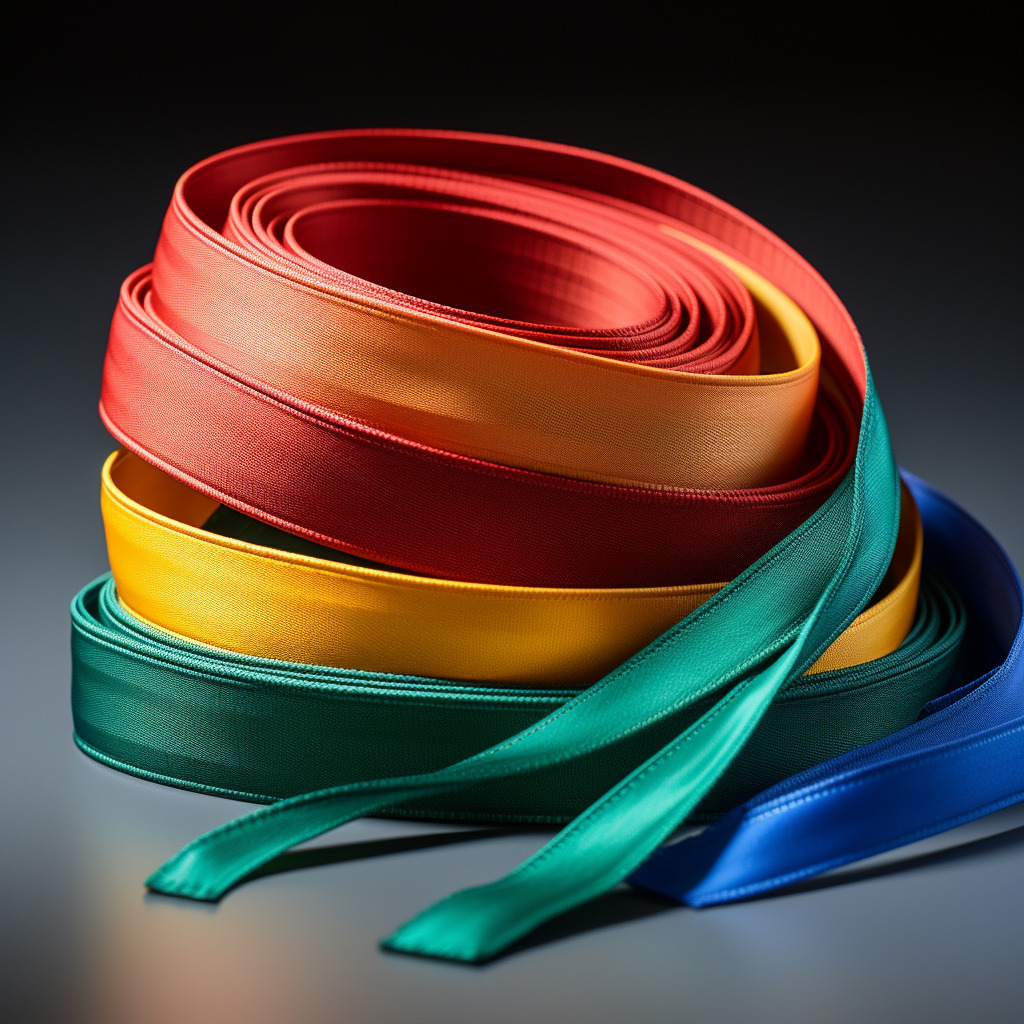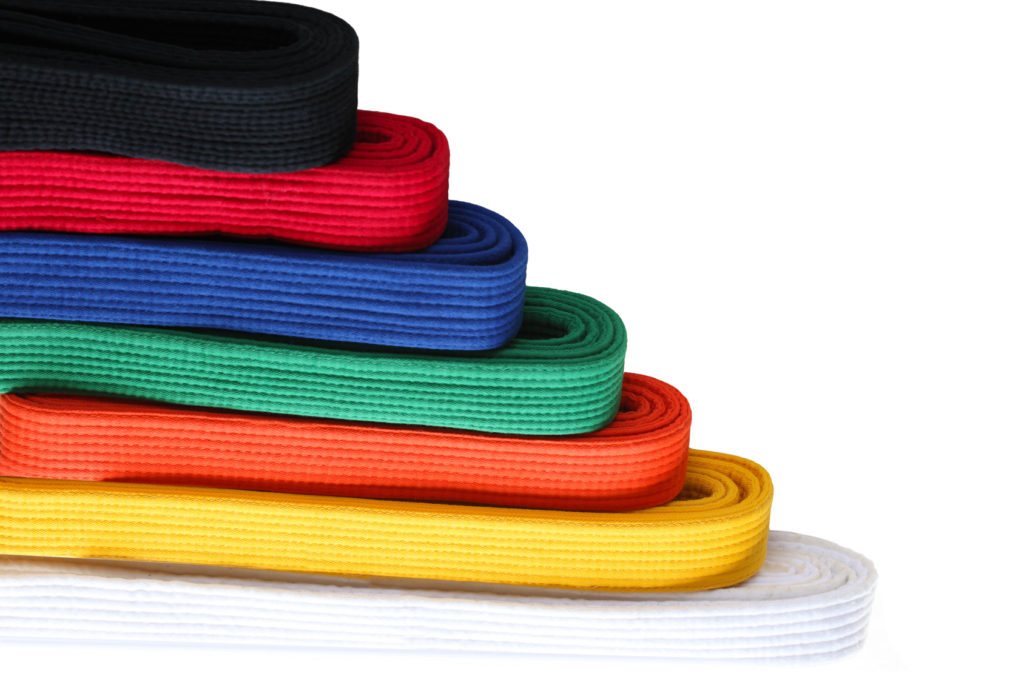Bei unterschiedlichen Kampfsportarten werden durch unterschiedliche Gürtelfarben die Kenntnisstände in der Kampfsport signalisiert. Auch beim Judo gibt der Gürtel Auskunft über den Fortschritt. Aber welche Bedeutung haben die Gürtelfarben und welche Grundsätze gelten bei Wettkämpfen? Wir geben Einblick in die Klasseneinteilung und Wettkampfklassen beim Judo.
In 30 Sekunden das Wichtigste:
- Beim Judo existieren Schülergrade (Kyū), mit bunten Gürteln sowie zehn Meistergrade (Dan), mit schwarzen Gürteln.
- Für den nächsthöheren Gürtel muss eine Prüfung erfolgreich absolviert werden. Dabei werden Falltechniken, Bodentechniken, Übungskämpfe sowie Kata’s (Abfolge von Übungen) abgefragt.
- Die Judo Ausrüstung wird noch durch einen Judoanzug komplettiert. Der Gürtel wird auf traditionelle Weise gebunden (siehe unten FAQ) und schließt den Anzug.
- Alle KWON-Budo-Gürtel sind aus 100%
- fester Baumwolle und mehrmals gesteppt.
- Es gibt sie in den Längen 200, 220,

Judo Gürtel Farben und Bedeutung
Ihr beginnt als 9. Kyū, als Kukyū, mit dem weißen Gurt, welchen Euch niemand absprechen kann, dann folgen die weiteren Gürtelfarben im Judo. Welche Anforderungen an die einzelnen Gürtelfarben gestellt werden, findet Ihr im Folgenden:
| Gürtelfarbe | Prüfungsinhalt |
| Weiß-Gelb Gürtel | Der 8. Kyū, der Hachikyū, trägt den weiß-gelben Gürtel und muss in seiner Prüfung rückwärts und seitlich fallen können. Außerdem werden 2 Wurf- und 2 Bodentechniken verlangt und 2 bis 3 Einheiten Randori von je einer Minute durchgeführt |
| Gelb Gürtel | In der Prüfung zum 7. Kyū mit gelbem Gürtel, dem Nanakyū, müsst Ihr eine Judorolle vorwärts beherrschen, je 2 zusätzliche Wurf- und Bodentechniken und 3 bis 4 Einheiten Randori zu je einer Minute demonstrieren. |
| Gelb-Orange Gürtel | Für den 6. Kyū, den Rokkyū, erhaltet Ihr gelb-orange und müsst die Judorolle beidseitig beherrschen. Außerdem erlernt Ihr 5 neue Wurftechniken, bekommt unfangreichere Anwendungsaufgaben und müsst 3 bis 5 Randori-Einheiten zu je 2 Minuten durchhalten. |
| Orange Gürtel | Der orangefarbene Gürtelträger nennt sich Gokyū und ist der 5. Kyū. Hier müsst Ihr die Judorolle über ein Hindernis vorführen und erlernt neue Wurftechniken, welche auf einem Bein ausgeführt werden, sowie Hebeltechniken am Boden. Randori bleibt wie beim 6. Kyū. |
| Orange-Grün Gürtel | Der Sprung zum orange-grünen 4. Kyū, dem Yonkyū, ist groß und Vorkenntnisse werden von hier an nur noch stichprobenartig geprüft. Hier müsst Ihr erstmals die fortgeschrittene Falltechnik „freier Fall“ demonstrieren. Zu den neuen Wurftechniken zählt der aus Filmen bekannte Tomoe-Nage. |
| Grün Gürtel | Für den 3. Kyū, auch Sankyū genannt und den damit verbundenen grünen Gürtel müsst Ihr die erste Kata erlernen. Beim Randori existieren weniger Vorgaben, damit ein ungezwungener Übungskampf stattfinden kann. Weitere Wurf- und Bodentechniken runden die Prüfung ab und Vorkenntnisse werden von hier an seltener abgefragt, da diese aus dem Prüfungsprogramm heraus ersichtlich sind. |
| Blau Gürtel | Wenn Ihr die Prüfung zum Nikyū, dem 2. Kyū mit blauem Gürtel, antretet, müsst Ihr erste Würgetechniken beherrschen und Euch in 3 Einheiten Randori zu je 3 Minuten gegen einen Gegner behaupten, welcher extreme Körperhaltungen einnimmt. Außerdem wird eine neue Kata gelehrt. |
| Braun Gürtel | Der letzte Schülergrad und Braungürtel, der 1. Kyū namens Ikkyū, verlangt Eure höchste Präzision und Flexibilität, denn hier werden keine Fehler mehr geduldet. Die Würfe und Hebel müssen aus verschiedenen Situationen heraus sicher angewandt werden, beim Randori werden 3 verschiedene Übungspartner ausgewählt und die dritte Kata muss zu beiden Seiten ausgeführt werden. |
| Schwarz Gürtel (1-10) | Die Prüfungsprogramme zu den Meistergraden 1. bis 10. Dan, allesamt Schwarzgurte (oder ab dem 6. Dan rot-weiß oder komplett rot), sind noch deutlich umfangreicher und umfassen neben neuen Techniken auch eine ständige Wiederholung des Gelernten. Ab der 3. Dan-Prüfung kann der Prüfling den Großteil der Techniken frei wählen. Weiterhin gehört zu jeder Dan-Prüfung ein Teil theoretischen Wissens, den der Prüfer abfragen kann. |
Gürtelfarbe vs. Alters und Gewichtsklasse
Beim Judo wird die Klasseneinteilung durch die Gürtelfarbe angegeben. Dabei müsst ihr grundsätzlich zwischen zwei Kategorien der Einteilung unterscheiden.
- Auf der einen Seite steht der individuelle Rang des Judoka, der am Judo Gürtel zu erkennen ist. Diesen Rang kann er durch das Absolvieren der Judo Prüfung zum entsprechend nächsten Rang erhöhen. Hierbei existieren genaue Vorgaben für das Mindestalter und die Prüfungsinhalte, die der Judoka beherrschen muss und diese sind für jeden von Euch gleich.
- Hiervon klar zu unterscheiden ist die Einteilung in Alters und Gewichtsklassen, wie sie beim Wettkampf vorgenommen wird, denn diese hat nichts mit dem Gürtelrang des Judoka zu tun. Sie soll lediglich eine bessere Vergleichbarkeit der Fähigkeiten im Wettkampf schaffen, indem Differenzen in Alter und Gewicht gering gehalten werden.
Einteilung in Schüler und Meistergrade
Wie oben schon erwähnt, repräsentiert der Gürtel Euren persönlichen Grad anhand seiner Farbe. Jeder Neuling startet mit dem Schülergrad des 9. Kyū und trägt den weißen Judo Gürtel, mit steigendem Schülergrad werden die Gürtelfarben dunkler und führen über gelb, orange, grün und blau nach braun. Ein Überspringen einzelner Grade ist nicht möglich.
Die Prüfungen führen schrittweise abwärts bis zum 1. Kyū, dem braunen Gürtel, woraufhin der nächste Schritt die Prüfung zum 1. Dan ist, dem Grad des niedrigsten Judo Meister und somit dem „Schwarzgurt“. Judo Prüfungen existieren bis zum 5. Dan, alle weiteren Grade werden bei großen Leistungen durch entsprechende Verbände verliehen. Ein Mindestalter existiert für den 5. Kyū (im 9. Lebensjahr), den 3. Kyū (im 11. Lebensjahr), den 1. Kyū (vollendetes 12. Lebensjahr) sowie den 1. Dan (vollendetes 15. Lebensjahr).
Wie sieht die Judo Prüfung zum höheren Grad aus?
Der Judoka muss eine Reihe von Techniken sicher vorführen können, welche mit steigendem Rang schwieriger werden.
- Ein erster Prüfungsbestandteil sind Falltechniken, bei denen der Schüler seinen Schwung abfangen muss, um Verletzungen zu verhindern. Das Fallen funktioniert in vier Richtungen.
Das Gegenstück dazu sind die Wurftechniken, mit denen der Gegner auf die Matte befördert wird. - Bei der Demonstration der Bodentechniken geht es darum, den Gegner in kniender oder fast liegender Haltung in Rückenlage und unter Kontrolle zu bringen.
- Beim Randori (Übungskampf) sollen die erlernten Techniken an einem Partner angewandt werden, welcher sich zur Wehr setzt.
- Ab dem 3. Kyū muss der Schüler zusammen mit einem Partner noch eine Kata vorführen, die auf den ersten Blick dem Randori ähnelt. Bei der Kata allerdings sind die anzuwenden Techniken genau vorgeschrieben und der Übungspartner wehrt sich nicht.
Die entsprechenden Techniken für die Prüfung stehen im Prüfungsprogramm und der Judoka muss alle beherrschen, wenn er die Prüfung bestehen will. Prinzipiell sollte der Schüler alle Techniken vergangener Prüfungen verinnerlicht haben. Der Prüfer ist bei höheren Graden auch berechtigt, diese abzufragen. Besonders in Dan Prüfungen machen Prüfer von dieser Option sehr gern Gebrauch und lassen Techniken vorführen, die zum Grundwissen jedes Judoka gehören, im aktuellen Prüfungsprogramm aber nicht speziell genannt sind. Es gilt also: Ihr lernt nicht nur für diese Prüfung, sondern für alle Folgenden.
Judo Gürtel kaufen
Die richtige Gürtellänge bestimmen
| Körpergröße | Gürtellänge |
| ca. 1,50 m | 2,30 m bis 2,50 m |
| 1,50 m bis 1,75 m | 2,50 m bis 2,70 m |
| 1,75 m bis 1,90 m | 2,70 m bis 3,00 m |
| 1,90 m | 3,00 m bis 3,30 m |

FAQ zu Judo Gürtel
Wir haben euch im Folgenden Antworten auf häufige Fragen zusammengestellt. Der Gürtel hält die Judohose und die Jacke in Form und gibt dem Judoanzug halt. Darüber hinaus gibt er Auskunft über die Kenntnisse bzw. bestandenen Prüfungen des Judoka.
- Boxsack Basics: Findet den perfekten Boxsack für euer Heimtraining - 23. November 2023
- Mobbing am Arbeitsplatz: Tipps & Hilfestellungen für Betroffene - 15. November 2023
- Wohnung & Haus effektiv vor Einbruch schützen: 10 Tipps & FAQ - 3. November 2023
Update: 2025-07-01 / Affiliate Links / Bilder von der Amazon Product Advertising API

